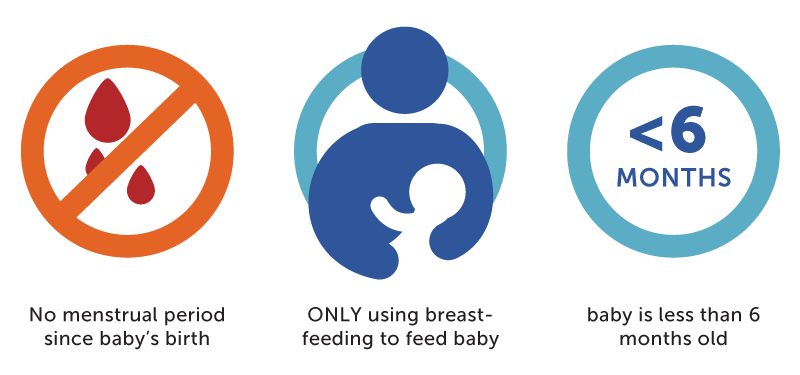Key Facts
- The Lactational Amenorrhea Method is a short-term and temporary birth control method (up to 6 months) for individuals born with female reproductive organs who have given birth and are exclusively breastfeeding.
- This birth control method is ONLY reliable if the parent has not had their period since giving birth, is breastfeeding a baby (who is less than 6 month) on demand (at least 6-10 times a day), both day and night and not replacing feedings with other foods or liquids.

The suckling (breast-feeding by a baby) changes how a person’s body works and stops a person’s ovaries from releasing an egg. When there is no egg, pregnancy can’t happen.
| Out of 100 women using the lactational amenorrhea method | |
| Typical use: 2 people become pregnant | |
| Perfect use: 2 people become pregnant | |
How effective is the Lactational Amenorrhea Method (LAM)?
If a person uses LAM and all the conditions are met, it’s 98% effective. This means that if 100 people use LAM perfectly, 2 people will become pregnant in a year. Perfect use means if a person (1) has not had their menstrual period since having their baby, (2) if they are ONLY using breast feeding to feed their baby (at least 6-10 times a day, including night feedings), and (3) if the baby is less than 6 months old. If any of these 3 facts are no longer true, LAM is very unreliable and a person should use a back-up method of contraception to protect against pregnancy. LAM does not protect against sexually transmitted infections (STIs) including HIV.
Are there any problems with LAM?
LAM is a very natural way to protect against pregnancy. You should contact your health care provider (HCP) when you get your menstrual period again. It’s very important to begin using birth control before your baby is 6 months old as LAM should only be considered a temporary type of birth control.
Our health guides are developed through a systematic, rigorous process to ensure accuracy, reliability, and trustworthiness. Written and reviewed by experienced healthcare clinicians from Boston Children's Hospital, a Harvard Medical School teaching hospital and consistently ranked as a top hospital by Newsweek and U.S. News & World Report, these guides combine clinical expertise, specialized knowledge, and evidence-based medicine. We also incorporate research and best practices from authoritative sources such as the CDC, NIH, PubMed, top medical journals, and UpToDate.com. Clinical specialists and subject matter experts review and edit each guide, reinforcing our commitment to high-quality, factual, scientifically accurate health information for young people.


